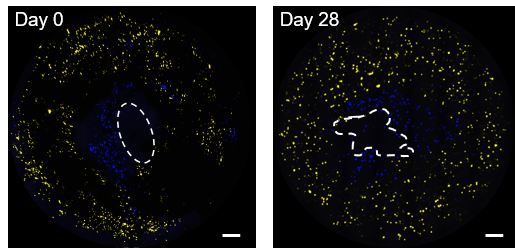Mar 18 2021
In a breakthrough study, Lund University researchers have developed a novel bioink through which tiny human-sized airways can be 3D-bioprinted using patients’ cells.
 3D-bioprinted small airways made out of two cell types (blue and yellow) remain open over time. Image Credit: Lund University.
3D-bioprinted small airways made out of two cell types (blue and yellow) remain open over time. Image Credit: Lund University.
These biocompatible 3D-printed constructs support the growth of new blood vessels into the transplanted material. This is a first crucial step toward 3D-printing organs. The research work has been published in the Advanced Materials journal.
Globally, chronic lung diseases are the third leading cause of death and involve an estimated EU cost of over €380 billion per year. As such, no treatment is available for the majority of chronic diseases, and only lung transplantation offers the end-stage option for patients. But still, sufficient donor lungs are not available to meet this clinical demand.
Hence, investigators are exploring new ways to boost the proportion of lungs available for transplantation. One way is to create lungs in laboratory settings by integrating cells with a bioengineered scaffold.
We started small by fabricating small tubes, because this is a feature found in both airways and in the vasculature of the lung. By using our new bioink with stem cells isolated from patient airways, we were able to bioprint small airways which had multiple layers of cells and remained open over time.
Darcy Wagner, Study Senior Author and Associate Professor, Lund University
The team initially created a novel bioink—that is, a printable material with cells—to bioprint human tissues in 3D.
The bioink was produced by integrating a couple of materials—an extracellular matrix obtained from lung tissue and a material obtained from seaweed.
The novel bioink supports the bioprinted material across many phases of its development toward human tissues.
The researchers subsequently utilized the bioink to 3D-bioprint tiny human airways comprising two cell types found in human airways. But this bioink can be modified for any type of organ or tissue.
These next-generation bioinks also support the maturation of the airway stem cells into multiple cell types found in adult human airways, which means that less cell types need to be printed, simplifying the nozzle numbers needed to print tissue made of multiple cell types.
Darcy Wagner, Study Senior Author and Associate Professor, Lund University
Wagner observed that the resolution had to be enhanced to 3D-bioprint more distal lung tissues as well as the air sacks, called alveoli, that are crucial for gas exchange.
“We hope that further technological improvements of available 3D printers and further bioink advances will allow for bioprinting at a higher resolution in order to engineer larger tissues which could be used for transplantation in the future. We still have a long way to go,” added Wagner.
The researchers employed a mouse model that closely resembled the immunosuppression utilized in patients who were undergoing organ transplantation.
When the 3D-printed constructs produced from the bioink were transplanted into the mouse model, the researchers observed that these constructs were well-tolerated and also supported the growth of new blood vessels.
The development of this new bioink is a significant step forward, but it is important to further validate the functionality of the small airways over time and to explore the feasibility of this approach in large animal models.
Martina De Santis, Study First Author, Lund University
Darcy Wagner – Developing therapies for patients with lung diseases
Video Credit: Lund University.
Journal Reference:
De Santis, M. M., et al. (2021) Extracellular‐Matrix‐Reinforced Bioinks for 3D Bioprinting Human Tissue. Advanced Materials. doi.org/10.1002/adma.202005476.